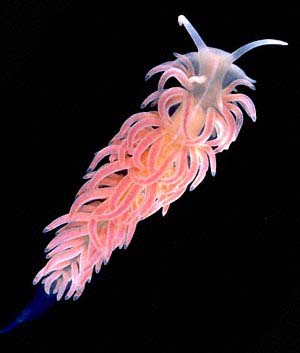
Phyllodesmium serratum
(Baba, 1949)
Order: NUDIBRANCHIA
Suborder: AEOLIDINA
Family: Glaucidae
DISTRIBUTION
Known from Japan and all states of Australia. Probably has wide tropical western Pacific distribution.
PHOTO
UPPER, LOWER LEFT: Tasman Peninsula, southern Tasmania, Australia, February 1984, 35mm long.
LOWER LEFT: Feeding on colony of stoloniferan octocoral Clavularia sp.
LOWER RIGHT: Feeding on gorgonian Junceela sp., Darwin, Northern Territory, Australia, November 1986, 14mm long.
PHOTOS: Bill Rudman.
Many species of Phyllodesmium, such as Phyllodesmium longicirrum, have evolved a symbiotic relationship with single-celled plants called zooxanthellae which they keep alive in their bodies, and living to some extent from the porducts of the zooxanthellae photosynthesis. These "solar-powered" nudibranchs are described elsewhere in the Forum. Phyllodesmium serratum does not have such a relationship, and is unusual in feeding on a wide variety of octocorals. In Tasmania and Victoria it feeds on the stoloniferan Clavularia sp and in New South Wales it is often found on the telestacean Carijoa sp.. The white animal figured here from the Darwin was one of a whole cluster of juveniles found feeding on the gorgonian Junceela sp. Interestingly they are the offspring of an animal which was collected feeding on the alcyonacean Steronephthya. As colour is dependent on the colour of the food they are eating, this species is highly variable in colour except for the white median dorsal line.
-
Rudman, W.B. (1981) The anatomy and biology of alcyonarian feeding aeolid opisthobranch molluscs and their development of symbiosis with zooxanthellae. Zoological Journal of the Linnean Society, 72: 219-262.
-
Rudman, W.B. (1991) Further studies on the taxonomy and biology of the octocoral-feeding genus Phyllodesmium Ehrenberg, 1831 (Nudibranchia: Aeolidoidea). Journal of Molluscan Studies, 57(2): 167-203.
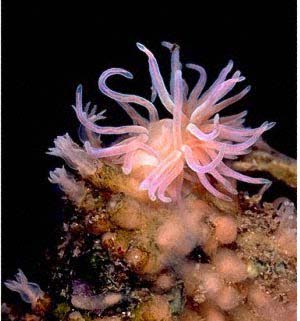
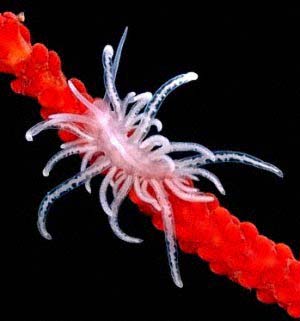
Rudman, W.B., 1999 (January 26) Phyllodesmium serratum (Baba, 1949). [In] Sea Slug Forum. Australian Museum, Sydney. Available from http://www.seaslugforum.net/find/phylserr
Related messages
Re: Phyllodesmium serratum from Port Phillip Bay, Victoria
February 11, 2009
From: Andy Barton
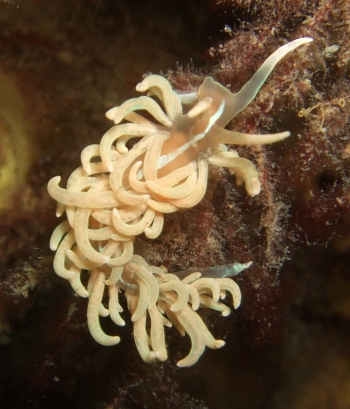
Concerning message #14866:
Locality: Blairgowrie, 5 m, Victoria, Australia, Port Phillip Bay, 8 February 2009, Marina breakwater. Length: 40 mm. Photographer: Andy Barton.
Andy Barton
andybarton@aol.com
Andy B, 2009 (Feb 11) Re: Phyllodesmium serratum from Port Phillip Bay, Victoria. [Message in] Sea Slug Forum. Australian Museum, Sydney. Available from http://www.seaslugforum.net/find/22248Thanks Andy,
Best wishes,
Bill Rudman
Phyllodesmium serratum ? from Tasmania
May 3, 2006
From: Robin Thomson

Simpson's Point, Tasmani is a great spot for finding nudibranchs. Its a patch of boulders, rich with sea whips and sponges, in the middle of a vast area of bare mud and scallop beds. We always find 4 or 5 different nudi species on every dive there. This is where my dive buddy and I recently found these 2 white nudis canoodling. Although the photo doesn't show it clearly, each animal had two distinct pairs of 'antennae'. Our best guess is that they are Phyllodesmium serratum but there was no white stripe down the back. There also seems to be a bewildering amount of variation in the Phyllodesmium. We decided to turn to the guru for enlightenment.
I'd also like to take this opportunity to say thanks very much for Sea Slug Forum. It's a wonderful resource. I'd probably be less interested in nudis if it wasn't for this well-compiled, accessible, information.
Locality: Simpson's Point, D'entrecasteaux channel, Hobart, 9.0 m, Tasmania, Australia, Southern ocean, 29 April 2006, Reef: rocks and mud. Length: 13 mm. Photographer: Mitchell Rolls.
Robin Thomson
robin.thomson@csiro.au
Thomson, R.B., 2006 (May 3) Phyllodesmium serratum ? from Tasmania. [Message in] Sea Slug Forum. Australian Museum, Sydney. Available from http://www.seaslugforum.net/find/16499
Dear Robin,
Despite the lack of a median white line I am pretty sure this is P. serratum. For a long time I tried to find some anatomical differences in the various colour forms of this species in south-eastern Australia and then I found specimens in Darwin which are apparently the same thing, indistingusihable from animals from Japan. I suppose in the future, DNA studies could show that what we are calling 'P. serratum' is a group of cryptic species, but at present there doesn't seem to be any anatomical characters to separate them. At one stage I was toying with the idea of defining species on the basis of their food, as P. serratum in New South Wales normally feeds on the telestacean soft-coral Carijoa sp. while in Tasmania I have found it on the stoloniferan Clavularia sp. I dropped this idea when I found aquarium juveniles in Darwin destroying a colony of the gorgonian Junceela, although their parents had been collected on the alcyonacean Steronephthya, suggesting that this species feeds on a much wider range of octocorals than other species in the genus.
Best wishes,
Bill Rudman
Phyllodesmium serratum from Port Phillip Bay, Victoria
October 10, 2005
From: Marc Saunders
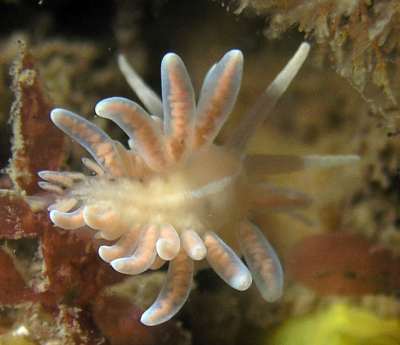
I found this little fellow (15 mm) in about 2 meters of water under the Mornington Pier, Port Phillip Bay, Victoria. I've not seen his kind before and would like to know if he is in fact Phyllodesmium serratum.
Locality: Mornington Pier, Port Phillip Bay. Victoria. Australia. Depth: 2 m
Length: 15 mm. 24 September 2005. Photographer: Marc Saunders
Marc Saunders
marc@irm.net.au
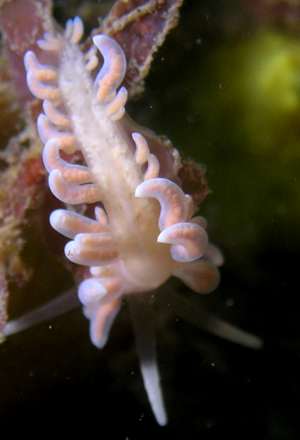
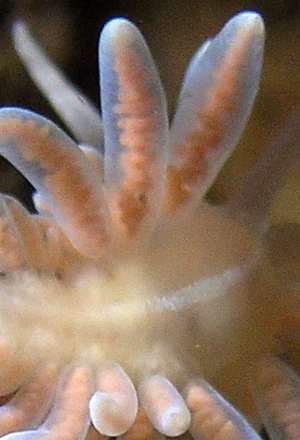
Dear Marc,
These photos came at a good time, as they are a good comparison for Sue Newson's animals [#14934] from Jervis Bay. Yours are indeed Phyllodesmium serratum. The pinkish coloured digestive gland ducts in the cerata, and the white line down the back are characteristics of this species. It is also one of the species of the genus which is NOT solar powered and so does not have any of the adaptations needed for zooxanthellae symbiosis, such as branching digestive gland in the cerata, flattened cerata, and branches of the digestive gland in the body wall. Like all species of Phyllodesmium, however it lacks cnidosacs at the thip of the cerata, instead having a layer of glandular secretory cells in the ceratal wall around the tip of each ceras. This can be seen as a white area in the close-up photo [lower right].
Best wishes,
Bill Rudman
Phyllodesmium serratum from Japan
February 10, 2004
From: Yukari Sato
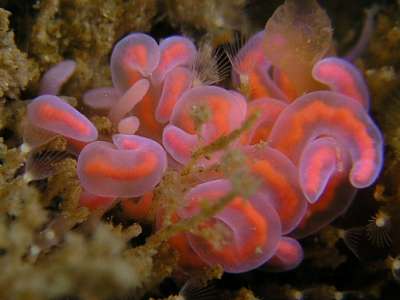
Hello Dr.Rudman,
Here are some photos of Phyllodesmium serratum. I am very happy to have found it as it is a sea slug I have been wanting to see for a long time.
The upper right photo shpows it as I found it. I moved it to get the other photos of it crawling.
Date: 20 Jan 2004
Depth: 20m
Size: 12mm.
Location: Zushi(near Hayama), Sagami Bay, Japan
Best regards,
Yukari Sato
yuks@cg7.so-net.ne.jp

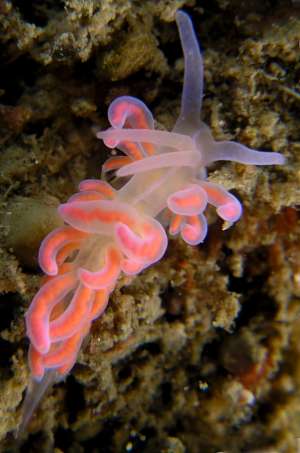
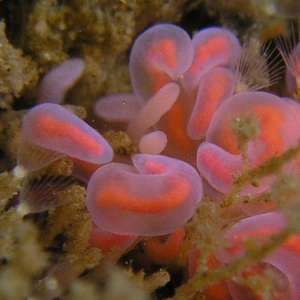
Dear Yukari,
I am also happy to at least see photos of this species from Japan. The animal in yoru photo is very similar to ones I have photographed from Tasmania, Australia [see Fact Sheet]. I have included a close-up of part of your photo because it shows the ends of the cerata very clearly, and shows how species of Phyllodesmium lack a cnidosac. Since the soft-corals they feed on lack the appropriate nematocysts, there is no point in storing them at the tips of their cerata for defence.
Best wishes
Bill Rudman
Re: Phyllodesmium serratum from Mornington Penins.
January 26, 1999
From: Bill Rudman
I have posted some information on Phyllodesmium serratum to illustrate Jane Breidahl's message about diving at Mornington Peninsula, Port Phillip Bay, Victoria.
Bill Rudman.
